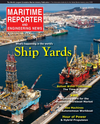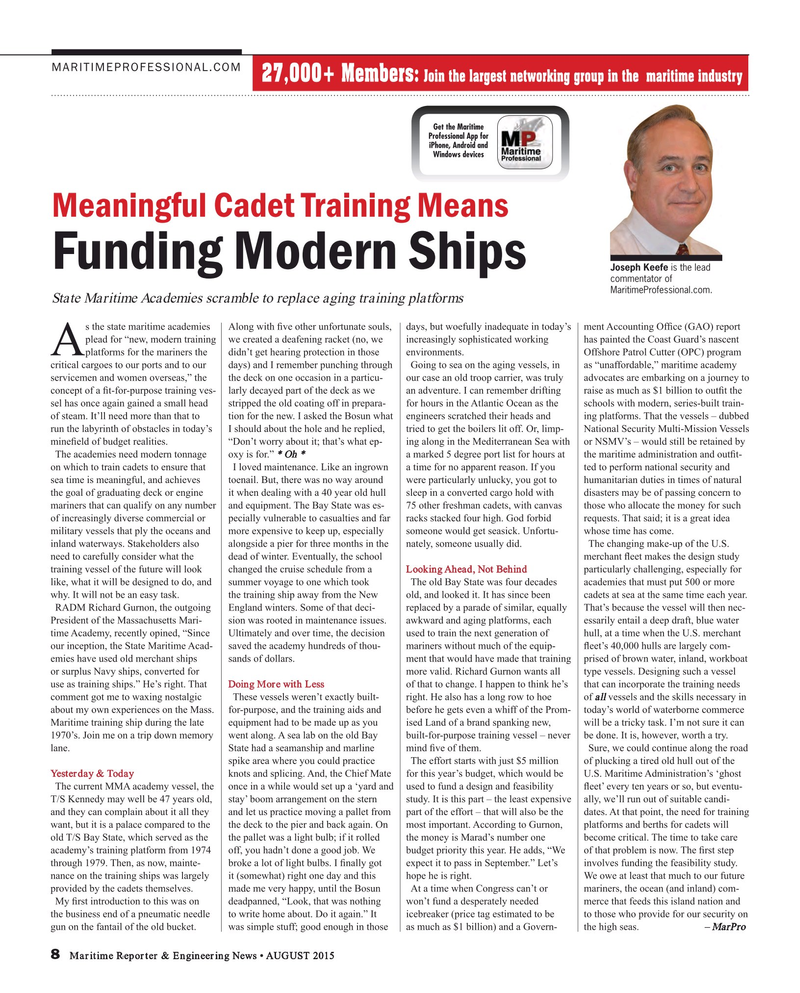
Page 8: of Maritime Reporter Magazine (August 2015)
Shipyard Edition
Read this page in Pdf, Flash or Html5 edition of August 2015 Maritime Reporter Magazine
MARITIMEPROFESSIONAL.COM 27,000+ Members: Join the largest networking group in the maritime industry
Get the Maritime
Professional App for iPhone, Android and
Windows devices
Meaningful Cadet Training Means
Funding Modern Ships
Joseph Keefe is the lead commentator of
MaritimeProfessional.com.
State Maritime Academies scramble to replace aging training platforms s the state maritime academies Along with ? ve other unfortunate souls, days, but woefully inadequate in today’s ment Accounting Of? ce (GAO) report plead for “new, modern training we created a deafening racket (no, we increasingly sophisticated working has painted the Coast Guard’s nascent
A platforms for the mariners the didn’t get hearing protection in those environments. Offshore Patrol Cutter (OPC) program critical cargoes to our ports and to our days) and I remember punching through Going to sea on the aging vessels, in as “unaffordable,” maritime academy servicemen and women overseas,” the the deck on one occasion in a particu- our case an old troop carrier, was truly advocates are embarking on a journey to concept of a ? t-for-purpose training ves- larly decayed part of the deck as we an adventure. I can remember drifting raise as much as $1 billion to out? t the sel has once again gained a small head stripped the old coating off in prepara- for hours in the Atlantic Ocean as the schools with modern, series-built train- of steam. It’ll need more than that to tion for the new. I asked the Bosun what engineers scratched their heads and ing platforms. That the vessels – dubbed run the labyrinth of obstacles in today’s I should about the hole and he replied, tried to get the boilers lit off. Or, limp- National Security Multi-Mission Vessels mine? eld of budget realities. “Don’t worry about it; that’s what ep- ing along in the Mediterranean Sea with or NSMV’s – would still be retained by
The academies need modern tonnage oxy is for.” * Oh * a marked 5 degree port list for hours at the maritime administration and out? t- on which to train cadets to ensure that I loved maintenance. Like an ingrown a time for no apparent reason. If you ted to perform national security and sea time is meaningful, and achieves toenail. But, there was no way around were particularly unlucky, you got to humanitarian duties in times of natural the goal of graduating deck or engine it when dealing with a 40 year old hull sleep in a converted cargo hold with disasters may be of passing concern to mariners that can qualify on any number and equipment. The Bay State was es- 75 other freshman cadets, with canvas those who allocate the money for such of increasingly diverse commercial or pecially vulnerable to casualties and far racks stacked four high. God forbid requests. That said; it is a great idea military vessels that ply the oceans and more expensive to keep up, especially someone would get seasick. Unfortu- whose time has come. inland waterways. Stakeholders also alongside a pier for three months in the nately, someone usually did. The changing make-up of the U.S. need to carefully consider what the dead of winter. Eventually, the school merchant ? eet makes the design study training vessel of the future will look changed the cruise schedule from a Looking Ahead, Not Behind particularly challenging, especially for like, what it will be designed to do, and summer voyage to one which took The old Bay State was four decades academies that must put 500 or more why. It will not be an easy task. the training ship away from the New old, and looked it. It has since been cadets at sea at the same time each year.
RADM Richard Gurnon, the outgoing England winters. Some of that deci- replaced by a parade of similar, equally That’s because the vessel will then nec-
President of the Massachusetts Mari- sion was rooted in maintenance issues. awkward and aging platforms, each essarily entail a deep draft, blue water time Academy, recently opined, “Since Ultimately and over time, the decision used to train the next generation of hull, at a time when the U.S. merchant our inception, the State Maritime Acad- saved the academy hundreds of thou- mariners without much of the equip- ? eet’s 40,000 hulls are largely com- emies have used old merchant ships sands of dollars. ment that would have made that training prised of brown water, inland, workboat or surplus Navy ships, converted for more valid. Richard Gurnon wants all type vessels. Designing such a vessel use as training ships.” He’s right. That Doing More with Less of that to change. I happen to think he’s that can incorporate the training needs comment got me to waxing nostalgic These vessels weren’t exactly built- right. He also has a long row to hoe of all vessels and the skills necessary in about my own experiences on the Mass. for-purpose, and the training aids and before he gets even a whiff of the Prom- today’s world of waterborne commerce
Maritime training ship during the late equipment had to be made up as you ised Land of a brand spanking new, will be a tricky task. I’m not sure it can 1970’s. Join me on a trip down memory went along. A sea lab on the old Bay built-for-purpose training vessel – never be done. It is, however, worth a try.
lane. State had a seamanship and marline mind ? ve of them. Sure, we could continue along the road spike area where you could practice The effort starts with just $5 million of plucking a tired old hull out of the
Yesterday & Today knots and splicing. And, the Chief Mate for this year’s budget, which would be U.S. Maritime Administration’s ‘ghost
The current MMA academy vessel, the once in a while would set up a ‘yard and used to fund a design and feasibility ? eet’ every ten years or so, but eventu-
T/S Kennedy may well be 47 years old, stay’ boom arrangement on the stern study. It is this part – the least expensive ally, we’ll run out of suitable candi- and they can complain about it all they and let us practice moving a pallet from part of the effort – that will also be the dates. At that point, the need for training want, but it is a palace compared to the the deck to the pier and back again. On most important. According to Gurnon, platforms and berths for cadets will old T/S Bay State, which served as the the pallet was a light bulb; if it rolled the money is Marad’s number one become critical. The time to take care academy’s training platform from 1974 off, you hadn’t done a good job. We budget priority this year. He adds, “We of that problem is now. The ? rst step through 1979. Then, as now, mainte- broke a lot of light bulbs. I ? nally got expect it to pass in September.” Let’s involves funding the feasibility study. nance on the training ships was largely it (somewhat) right one day and this hope he is right. We owe at least that much to our future provided by the cadets themselves. made me very happy, until the Bosun At a time when Congress can’t or mariners, the ocean (and inland) com-
My ? rst introduction to this was on deadpanned, “Look, that was nothing won’t fund a desperately needed merce that feeds this island nation and the business end of a pneumatic needle to write home about. Do it again.” It icebreaker (price tag estimated to be to those who provide for our security on gun on the fantail of the old bucket. was simple stuff; good enough in those as much as $1 billion) and a Govern- the high seas. – MarPro 8 Maritime Reporter & Engineering News • AUGUST 2015
MR #8 (1-9).indd 8 MR #8 (1-9).indd 8 8/9/2015 9:48:08 AM8/9/2015 9:48:08 AM

 7
7

 9
9
